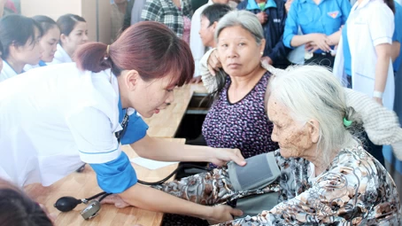The Ministry of Health has just issued "Guidelines for diagnosis and treatment of dengue fever applicable at medical examination and treatment facilities nationwide", replacing the "Guidelines for diagnosis and treatment of dengue fever" issued with Decision No. 3705/QD-BYT of the Ministry of Health issued on August 22, 2019.
According to the Ministry of Health , dengue fever is an infectious disease caused by the Dengue virus. This virus has 4 serotypes: DEN-1, DEN-2, DEN-3 and DEN-4; transmitted from sick people to healthy people by mosquito bites. The Aedes aegypti mosquito is the main vector of the disease.
The disease occurs year-round, often increasing during the rainy season. The disease occurs in both children and adults with diverse clinical manifestations, progressing rapidly from mild to severe. Characteristics of dengue hemorrhagic fever are fever, bleeding and plasma leakage, which can lead to hypovolemic shock, blood clotting disorders, organ failure, if not diagnosed early and treated promptly, can easily lead to death.
Clinical course of dengue fever
Dengue fever usually starts suddenly and progresses through 3 stages: fever stage; dangerous stage; recovery stage.
The febrile phase has clinical manifestations: Sudden, continuous high fever; headache, loss of appetite, nausea; skin congestion; muscle pain, joint pain, pain in both eye sockets; often with petechiae under the skin, bleeding gums or nosebleeds...
The dangerous stage is usually on the 3rd - 7th day. The patient may still have a fever or the fever may have subsided and may have the following symptoms: Severe and continuous abdominal pain or increased pain, especially in the liver area; restlessness, lethargy, lethargy; enlarged liver > 2cm below the rib cage, may be painful; vomiting.
Patients have signs of plasma leakage due to increased vascular permeability (usually lasting 24 - 48 hours) such as: Pleural effusion, interstitial tissue (can cause respiratory failure), peritoneum, eyelid edema. If there is a lot of plasma leakage, it will lead to shock with symptoms of restlessness, restlessness or lethargy, cold extremities, rapid and weak pulse, stuck blood pressure (difference between maximum and minimum blood pressure ≤ 20mmHg or hypotension, blood pressure cannot be measured, pulse cannot be felt, cold skin, purple veins (severe shock), little urine.
Patients have symptoms of subcutaneous bleeding (scattered petechiae or petechiae usually on the front of both calves and the inside of both arms, abdomen, thighs, ribs or bruises); mucosal bleeding (bleeding gums, nosebleeds, vomiting blood, passing black or bloody stools, vaginal bleeding or hematuria); severe bleeding: severe nosebleeds (requiring wicks or hemostatic gauze), severe vaginal bleeding, bleeding in muscles and soft tissues, bleeding in the digestive tract and internal organs (lungs, brain, liver, spleen, kidneys), often accompanied by shock, thrombocytopenia, tissue hypoxia and metabolic acidosis that can lead to multiple organ failure and severe intravascular coagulation.
Severe bleeding can also occur in patients taking anti-inflammatory drugs such as acetylsalicylic acid (aspirin), ibuprofen or corticosteroids, a history of gastric or duodenal ulcers, or chronic hepatitis.
Some severe cases may have organ failure such as severe liver damage/liver failure, kidney, heart, lung, brain. These severe manifestations can occur in patients with or without shock due to plasma leakage: Severe liver damage, acute liver failure, liver enzymes AST, ALT ≥ 1000U/L; acute kidney damage/failure; impaired consciousness (cerebral dengue hemorrhagic fever); myocarditis, heart failure, or failure of other organs.
The recovery phase is usually on the 7th - 10th day of the disease with clinical manifestations: The patient has no fever, general condition improves, appetite, stable hemodynamics and frequent urination; there may be a rash or itching on the skin; the heart rate may be slow and irregular; there may be respiratory failure due to fluid overload.
8 cases that should be considered for hospitalization
In this new guideline, the Ministry of Health also provides 8 cases that need to be considered for hospitalization when sick, including: Patients living alone; living far from medical facilities, unable to be hospitalized in time when the disease becomes severe; families unable to closely monitor; infants; overweight, obese; pregnant women; people over 60 years old; accompanying chronic diseases (kidney, heart, liver, asthma, poorly controlled COPD, diabetes, hemolytic anemia...).
According to the Ministry of Health, most cases of dengue fever are treated as outpatients and monitored at primary health care facilities. However, during the course of the disease, the disease can progress from mild to severe, so when examining, it is necessary to classify the clinical stage to predict the disease and have an appropriate treatment plan. Early detection and understanding of clinical problems in each stage of the disease helps to diagnose early, treat correctly and promptly, in order to save the patient's life.
Signs that you need to go to a medical facility immediately
Patients need to have daily check-ups and tests. If warning signs appear, they should be hospitalized for treatment.
Patients should return to a medical facility for a check-up immediately if they have one of the following symptoms:
1. Feeling more tired, restless, and uncomfortable even though the fever has decreased or gone.
2. Can't eat or drink
3. Vomiting a lot.
4. Severe stomach pain.
5. Cold, damp hands and feet.
6. Bleeding from the nose, mouth or vagina.
7. No urination for more than 6 hours./.
Source


![[Photo] General Secretary To Lam works with the Central Policy and Strategy Committee](https://vphoto.vietnam.vn/thumb/1200x675/vietnam/resource/IMAGE/2025/5/28/7b31a656d8a148d4b7e7ca66463a6894)
![[Photo] 12th grade students say goodbye at the closing ceremony, preparing to embark on a new journey](https://vphoto.vietnam.vn/thumb/1200x675/vietnam/resource/IMAGE/2025/5/28/42ac3d300d214e7b8db4a03feeed3f6a)
![[Photo] Vietnamese and Hungarian leaders attend the opening of the exhibition by photographer Bozoky Dezso](https://vphoto.vietnam.vn/thumb/1200x675/vietnam/resource/IMAGE/2025/5/28/b478be84f13042aebc74e077c4756e4b)

![[Photo] Prime Minister Pham Minh Chinh receives a bipartisan delegation of US House of Representatives](https://vphoto.vietnam.vn/thumb/1200x675/vietnam/resource/IMAGE/2025/5/28/468e61546b664d3f98dc75f6a3c2c880)





















































































Comment (0)